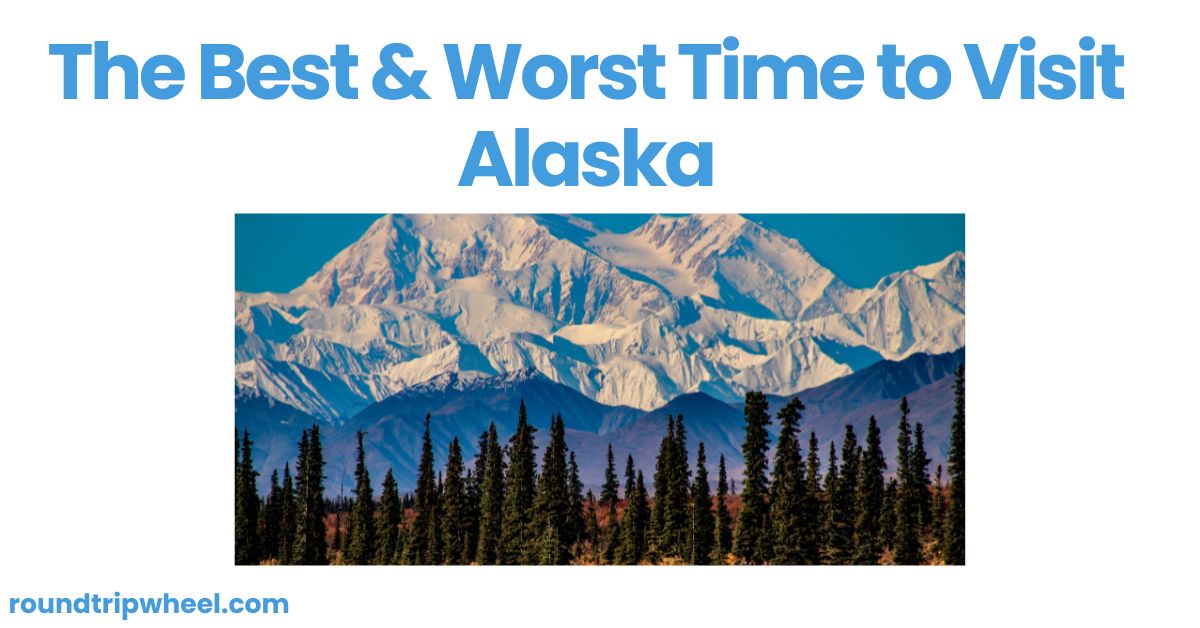The Best & Worst Time to Visit Alaska

Alaska, the Last Frontier, is a land of breathtaking natural beauty, rugged wilderness, and diverse landscapes. From towering snow-capped mountains and majestic glaciers to pristine forests and tundra teeming with wildlife, this vast state offers an unparalleled adventure for travelers. However, choosing the right time to visit can make or break your Alaskan experience. In this article, we’ll explore the best and worst times to plan your trip, taking into account factors such as weather, daylight hours, wildlife viewing opportunities, and peak tourist seasons.
The Best Time to Visit Alaska
Summer (Late May to Mid-September)
Summer is undoubtedly the best time to visit Alaska for most travelers. This period, from late May to mid-September, is often referred to as the peak season, offering a wealth of opportunities to explore the state’s natural wonders.
Weather: Summer in Alaska is relatively mild, with daytime temperatures ranging from the 60s to the low 80s Fahrenheit. While the Interior region can experience warmer temperatures, coastal areas like Southeast Alaska tend to be cooler. It’s important to note that Alaska’s climate can be unpredictable, and rain showers are common, especially in the coastal regions.
Daylight Hours: One of the biggest draws of visiting Alaska during the summer is the abundance of daylight. From late May to late July, much of the state experiences the “Midnight Sun,” where the sun remains visible for 24 hours or very close to it. This extended daylight allows for longer days of exploration and outdoor activities.
Wildlife Viewing: Summer is the prime time for wildlife viewing in Alaska. This is when bears, moose, caribou, and other iconic Alaskan animals are most active. Whale watching tours along the coastal regions offer the chance to spot humpback whales, orcas, and other marine life. Bird enthusiasts can witness the return of migratory species, and wildflowers bloom in vibrant colors, transforming the landscape.
Activities: Summer is the peak season for outdoor activities in Alaska. Hiking, camping, fishing, rafting, kayaking, and flightseeing tours are all popular pursuits during this time. Many national parks, such as Denali and Glacier Bay, offer their full range of services and visitor experiences.
Cruise Season: Alaska’s cruise season aligns with the summer months, typically running from May through September. This is an excellent opportunity to explore the state’s coastal regions, including the Inside Passage, and experience the stunning glaciers and fjords from the comfort of a cruise ship.
Shoulder Seasons (Late April to Early May and Late September to Early October)
While summer is the most popular time to visit Alaska, the shoulder seasons of late April to early May and late September to early October can offer a unique and rewarding experience for those seeking fewer crowds and lower prices.
Weather: During the shoulder seasons, temperatures are cooler than the peak summer months, but still pleasant enough for outdoor activities. In late April and early May, daytime highs can range from the 40s to the 60s Fahrenheit, while late September and early October can see temperatures in the 50s and 60s.
Daylight Hours: In late April and early May, the days are getting longer, with around 16-18 hours of daylight. By late September and early October, the daylight hours start to decrease, but there’s still plenty of time for outdoor adventures.
Wildlife Viewing: The shoulder seasons can be excellent times for wildlife viewing in Alaska. In the spring, you may catch the tail end of the gray whale migration or witness the return of migratory birds. Fall is a prime time for viewing bears as they prepare for hibernation and feast on spawning salmon.
Activities: While some summer activities may be winding down or not yet in full swing during the shoulder seasons, there are still plenty of opportunities for hiking, fishing, and exploring the great outdoors. Additionally, fall foliage can be stunning, with the tundra and forests ablaze in vibrant shades of red, orange, and yellow.
Prices and Crowds: One of the biggest advantages of visiting Alaska during the shoulder seasons is the potential for lower prices on accommodations, tours, and activities. Crowd levels are also typically lower, allowing for a more peaceful and intimate experience in popular destinations.
The Worst Time to Visit Alaska
While Alaska is a year-round destination, there are certain times of the year that can be less favorable for most travelers, primarily due to extreme weather conditions and limited daylight hours.
Winter (Mid-November to Late March)
Alaska’s winters are notoriously harsh, with freezing temperatures, heavy snowfall, and limited daylight hours. While this season can offer unique experiences for adventure seekers and aurora enthusiasts, it may not be the best time for those seeking a more traditional Alaskan vacation.
Weather: Winter in Alaska can be brutal, with temperatures dropping well below freezing, especially in the Interior region. In Fairbanks, for example, average temperatures in January can reach as low as -20°F (-29°C). Coastal areas like Juneau and Anchorage are generally milder, but still experience significant snowfall and icy conditions.
Daylight Hours: During the winter months, Alaska experiences extended periods of darkness, with some regions experiencing complete darkness for several weeks. In Barrow, located within the Arctic Circle, the sun doesn’t rise at all from late November to late January. Even in Anchorage, daylight hours can be as little as 5-6 hours during the depths of winter.
Wildlife Viewing: While some hardy wildlife remains active during the winter, such as moose, caribou, and birds of prey, many species migrate or hibernate, making wildlife viewing opportunities more limited.
Activities: Winter in Alaska offers unique activities like dog sledding, snowmobiling, and aurora viewing. However, many popular summer activities and attractions may be closed or have reduced operations. National parks and remote areas can be challenging to access due to weather conditions and limited services.
Accessibility and Closures: During the winter months, some roads, trails, and facilities may be closed due to snow and ice. Transportation services, including flights and ferries, can also be disrupted by adverse weather conditions, making travel more challenging.
Early Spring (Late March to Early April)
While spring in Alaska can be a beautiful time, the transition from winter to summer can be unpredictable and challenging for travelers.
Weather: In early spring, temperatures can fluctuate widely, with a mix of snow, rain, and occasional warm spells. This can make outdoor activities and travel logistics more difficult to plan.
Daylight Hours: By late March and early April, the days are getting longer, but there may still be limited daylight hours for outdoor exploration, particularly in the northern regions of the state.
Wildlife Viewing: Many animals are just emerging from hibernation or starting their migrations during this time, making wildlife sightings less frequent or predictable.
Activities: Some winter activities, such as dog sledding and snowmobiling, may still be available in early spring, but summer activities like hiking and fishing may not have fully opened up yet. Additionally, some parks and attractions may have limited operations or be closed as they prepare for the summer season.
Accessibility and Closures: As the snow and ice start to melt, roads and trails can become muddy and impassable in some areas, limiting access to certain destinations.
It’s important to note that while these are general guidelines, Alaska’s vast size and diverse landscapes mean that conditions can vary significantly from region to region. Additionally, factors like climate change and unpredictable weather patterns can influence the timing and intensity of seasons. It’s always best to research and plan your trip carefully, taking into account your specific interests, desired activities, and tolerance for different weather conditions.
Conclusion
Alaska is a destination that offers unique experiences and natural wonders throughout the year. However, the best time to visit largely depends on your personal preferences and the type of experiences you seek. The summer months from late May to mid-September provide the most ideal conditions for outdoor activities, wildlife viewing, and access to popular attractions. The shoulder seasons of late April to early May and late September to early October can offer fewer crowds, lower prices, and stunning fall foliage.
While winter and early spring may not be the most favorable times for most travelers, they can still offer unique opportunities for those seeking adventure and a chance to witness the breathtaking northern lights or experience the thrill of winter sports.
Ultimately, no matter when you choose to visit, Alaska promises to leave a lasting impression with its unparalleled natural beauty and untamed wilderness. By carefully planning your trip and being prepared for the potential challenges and rewards of each season, you can ensure an unforgettable Alaskan adventure tailored to your interests and preferences.

About Author
Hey there, fellow explorers! I’m Mark Rodriguez, a big fan of adventures and always hungry for more. Packed with stories and a trusty camera, I’m on a mission to explore cool places around the world.
I love diving into new cultures and landscapes. As a travel writer, my goal is to get you excited about stepping out of your comfort zone, trying new things, and discovering the awesome magic our world has.
Check out my blog for cool stories, travel ideas, and helpful tips to plan your own amazing getaway!






